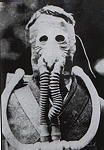
Fleuss' design 1878
Introduction
The Dräger company was founded in Lübeck Germany in 1889. Dräger was active in the valve industry and manufactured reducing valves for beertaps. At the turn of the century scientists had found ways to pressurize oxygen and carbonic acid (carbon doixide) in tanks up to 100 to 150 atm/bar. Dräger used this technique in conbination with their valve knowledge to manufacture oxygen breathing and later rebreating devices after scientists found out that scrubber, or in German alkali, chemically known as NaOH, has the property to absorb the moist and carbon dioxide from exhaled air. Through this they were capable to regenerate air. The new device became wide spread for use in toxic environments.
| It worked as follows: A facemask is attached to two tubes (1 for inhaling, 1 for exhaling). They are both connected to a breathing bag. Inside the breathing bag is a small pressurized oxygen tank and an alkali canister. Before use the bag is blown up with exhaled air. Some oxygen from the tank was then added to enrich it. The mouthpiece was then put in the wearers mouth. When the diver inhales the bag schrinks and the oxygen is taken from it. When he exhales, the air goes through the alkali canister, CO2 is taken from it and the breathing bag is blown up again. Before the wearer can inhale again the air in enriched by oxygen from the tank. The guy that deserves the credit of inventing the first workable underwater rebreather was Englishman Henry Fleuss. In 1878 he used this principle to build his rebreather system that would later be modell to the British escape apparatus and the German tauchretter. |
|
In 1906, Hermann Stelzner joined the Dräger company. Under his command the company started tests to develop the breathing device for toxic environments to a hoseless regenerating diving system. This resulted in two different pieces of equipment. First the Tauchretter, especially designed to save sailors from sunken submarines. Second the helmet diving equipment. Dräger was the worlds first company to "get rid of the hose !" Visit the "Hall of Fame" to learn more about genius Hermann Stelzner.
|
|
|
|
Tauchretter rebreather diving equipment 1912 |
Helmet rebreather diving equipment 1912 |
Like other German helmet producers, Dräger used the French Denayrouze 3 bolt design as a basis for their helmets and then made adjustments.
|
|
|
|
|
For a short
while Dräger produced 2 bolt helmets with a strong broad flenge. |
||
|
|
|
Besides self contained systems, Draeger worked with ordinary air helmets as well. This picture was taken around 1922. The one cylinder rotary pump is a rare find these days and worth a small fortune. Photo courtesy of Draeger. |